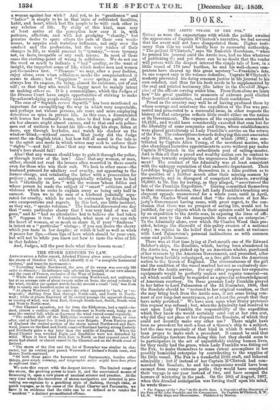THE STORM REDUCED TO LAW.
AiincrPVIING a fuller report, Admiral Fitzroy gives some particulars of the storm of October 25-6, which identify it as "a complete horizontal cyclone," and trace its movement—
"Travelling bodily Northward, the area of its sweep was scarcely 300 miles in diameter • its influence only affected the breadth of our own islands and the coast of France exclusive of the West of Ireland.
"While the central was advancing Northward, not uniformly, but at an average rate of about twenty miles an hour, the actual velocity of the wind, circling (as against watch-hands) around a small lull,' was from fifty to nearly one hundred miles an hour.
"At places Westward of its centre the wind appeared to back,' or re- trograde ; ' shifting from East through North-east, and North to North- west ; while at places Eastward of its central passage the apparent change, or veering of wind, was from East, through South-east, South, South-west and West to North-west.
"Our Channel squadron, not far from the Eddystone, had a rapid—in- deed, almost a sudden—shift from South-east to North-west, being in or near the central lull, while at Guernsey the wind veered round regularly. "The sudden shift off the Eddystone occurred at about three, or soon after, and at half-past five it took place near Reigate. From Eastern parts of England the central portion of the storm moved Northward and East- ward, places on the East and North coasts of Scotland having strong Easterly and Northerly gales a day later than the middle of England. When the Royal Charter was wrecked Elgin and Banffshire were not disturbed by wind. When it blew hard from East to North on that exposed coast the storm had abated or almost ceased in the Channel and on the South coast of Ireland.
"The storm of the 31st and the 1st of November was similar in cha- racter, but its central part passed Westward of Ireland's South coast, and thence North-eastward.
"Of both these gales the barometer and thermometer' besides other things, gave ample warning, and telegraphic notice might have been given in sufficient time."
We note this report with the deepest interest. The limited range of the storm, the growing power to trace it, and the ascertained means of foreseeing it, open a new phase of nautical science and practice. At the very time when the incentives of steam-navigation are detected in pro- voking sea-captains to a gambling style of dashing, through risks, at quick voyages, as in the cases of the Royal Charter and Paramatta, we have it on evidence that the risks can be so defined sate render the " accident " a distinct premeditated offence.


























 Previous page
Previous page